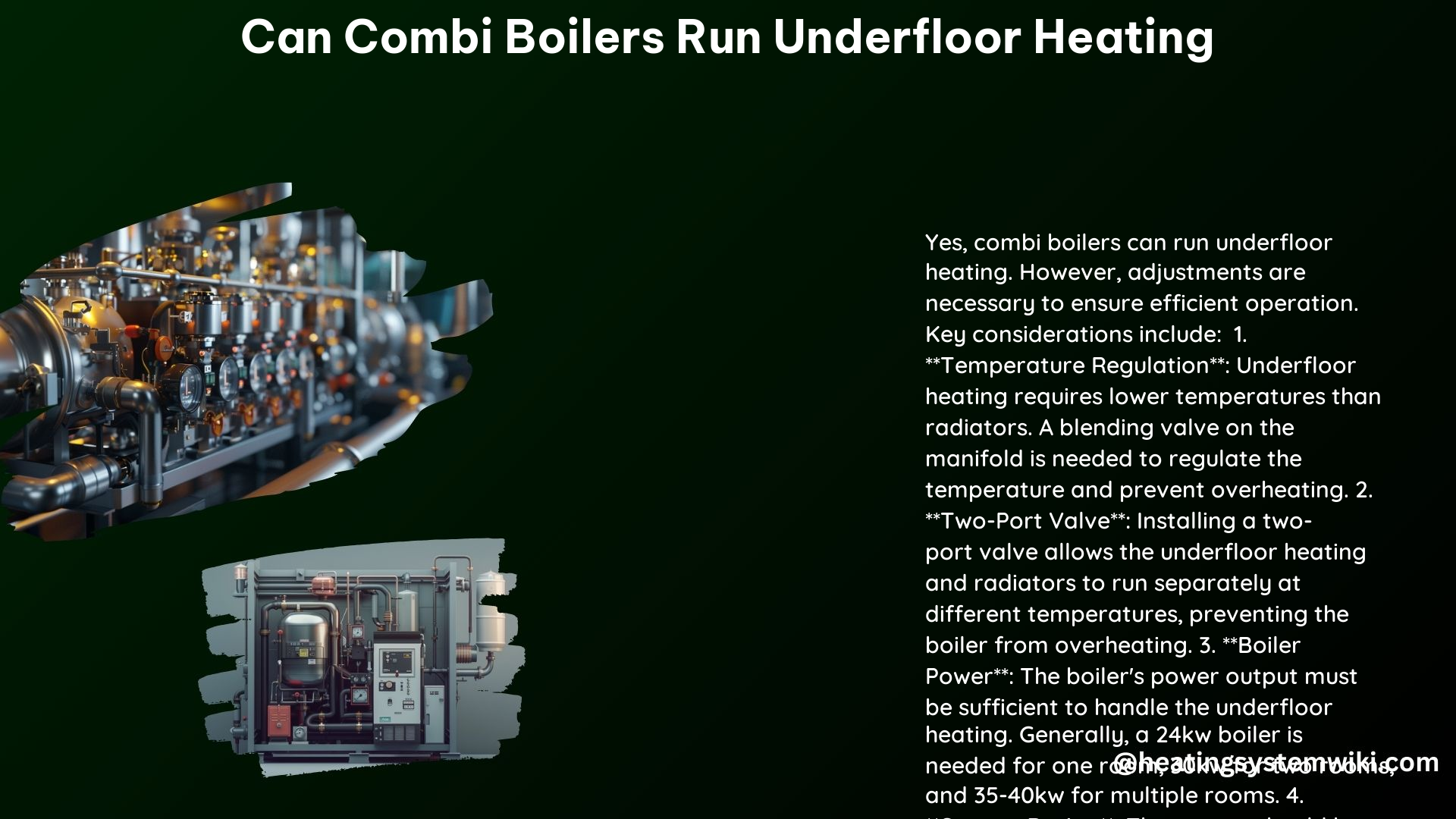Yes, combi boilers can run underfloor heating (UFH) systems, but there are specific considerations and adjustments required to ensure efficient and safe operation. This comprehensive guide will delve into the technical details, benefits, and installation requirements for integrating a combi boiler with an underfloor heating system.
How Underfloor Heating Works with Combi Boilers
Underfloor heating systems can be either wet or dry. Wet UFH systems use hot water from the boiler to heat the floor, while dry systems use electrical wires. Wet systems are more commonly used with combi boilers due to their ability to provide both heating and hot water.
To install a wet UFH system with a combi boiler, the following key components are required:
-
Two-Port Valve: This valve controls the flow of water in the central heating system, allowing the radiators and UFH to run separately at different temperatures. This prevents the boiler from overheating and going into fault mode.
-
Blending Valve: This valve is used to regulate the temperature of the water in the UFH pipes, ensuring it does not exceed the recommended temperature for the floor surface, typically around 29°C (84°F).
-
Buffer Cylinder: If the boiler is too large for the UFH system, a buffer cylinder may be needed to act as a heat store, especially if there are radiators on the same system. This helps to prevent the boiler from short-cycling and ensures a more stable water temperature.
-
Manifold: A manifold is used to distribute the heated water from the boiler to the various UFH zones or circuits, allowing for individual temperature control in different areas of the home.
-
Thermostats and Controls: Programmable thermostats and zone controls are essential for managing the temperature and runtime of the UFH system, ensuring optimal comfort and energy efficiency.
Benefits and Considerations

Benefits of Combi Boilers with Underfloor Heating
-
Cost-Effective: Combi boilers are generally less expensive to purchase and install compared to heat pumps, making them a more cost-effective option for homeowners looking to integrate UFH.
-
Energy Efficiency: When designed and installed correctly, UFH systems can be highly energy-efficient, especially when paired with a combi boiler that is sized appropriately for the heating load.
-
Flexibility: Designing the system for low-temperature operation (typically 35-45°C or 95-113°F) allows for easy integration with a heat pump in the future, should the homeowner wish to upgrade their heating system.
Considerations and Challenges
-
Installation Complexity: Integrating the UFH pipework with the floor structure can be a complex process, requiring careful planning and execution to ensure proper insulation and heat distribution.
-
Boiler Sizing: Ensuring the combi boiler is correctly sized for the UFH system is crucial. Oversizing can lead to short-cycling and inefficient operation, while undersizing can result in insufficient heating.
-
Temperature Regulation: The blending valve plays a critical role in maintaining the appropriate water temperature for the UFH system, typically lower than that required for radiators. Proper commissioning and adjustment of the blending valve are essential.
-
Zoning and Controls: Effective zoning and controls, such as programmable thermostats and zone valves, are necessary to optimize the performance and energy efficiency of the combined combi boiler and UFH system.
Technical Specifications
Boiler Power Requirements
The required boiler power for a combi boiler running an underfloor heating system depends on the number of rooms or zones being heated:
- Single Room UFH: A 24kW combi boiler is typically sufficient.
- Two-Room UFH: A 30kW combi boiler is recommended.
- Multiple Rooms UFH: A 35-40kW combi boiler is generally required to provide adequate heating capacity.
It’s important to note that these are general guidelines, and the actual boiler size required may vary depending on factors such as the size of the rooms, insulation levels, and the overall heating load of the property.
Temperature Regulation
The blending valve is a crucial component in ensuring the water temperature in the UFH pipes is maintained at the appropriate level, typically between 35-45°C (95-113°F). This lower temperature range is necessary to prevent the floor surface from overheating and causing discomfort or potential damage to the floor structure.
The blending valve mixes the hot water from the boiler with cooler return water from the UFH system, creating a blended supply temperature that is suitable for the underfloor heating. Proper commissioning and adjustment of the blending valve are essential to achieve the desired water temperature and ensure the system operates efficiently.
Conclusion
In conclusion, combi boilers can effectively run underfloor heating systems, but it is essential to consider the specific requirements and adjustments needed for a successful installation. Consulting a qualified heating engineer is recommended to ensure the system is designed and installed correctly, taking into account factors such as boiler sizing, temperature regulation, and zoning controls.
By understanding the technical specifications and considerations involved in integrating a combi boiler with an underfloor heating system, homeowners can make informed decisions and enjoy the benefits of a cost-effective and energy-efficient heating solution.
References:
- Viessmann UK. (2022). Can you have underfloor heating with a combi boiler? Retrieved from https://www.viessmann.co.uk/en/heating-advice/boilers/underfloor-heating-and-combi-boilers.html
- Homebuilding. (2022). Underfloor heating with combi boilers: Pros, cons and more. Retrieved from https://www.homebuilding.co.uk/advice/underfloor-heating-with-combi-boiler
- Reddit. (2022). Can I install underfloor heating on an existing combi boiler? Retrieved from https://www.reddit.com/r/DIYUK/comments/zxmouz/can_i_install_underfloor_heating_on_an_existing/
- Plumbnation. (2022). Can You Have Underfloor Heating With A Combi Boiler? Retrieved from https://www.plumbnation.co.uk/blog/can-you-have-underfloor-heating-with-a-combi-boiler
- Heatable. (2023). Underfloor Heating with Combi Boiler – Pros, Cons & Costs. Retrieved from https://heatable.co.uk/boiler-advice/boiler-with-underfloor-heating
